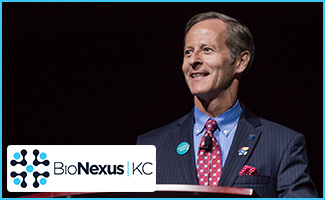
BioNexus KC’s 2018 Annual Dinner focused on opportunities for improvement in the American health care model. The event featured Dr. David Nash, Dean of the Jefferson College of Population Health at Thomas Jefferson University. His presentation, Leadership for Improving Health, discussed our current healthcare model in three parts:
1: What is the problem?
-Our society is spending a lot on healthcare and not a lot on health.
2: What is Population Health?
-An approach that aims to prevent human disease through social interventions. This differs from conventional healthcare by replacing volume of services rendered with value of healthcare delivery.
3: How do we move forward?
-Transparency. Accountability. No outcome, no income. “The more we spend on social service the better the health of the population and healthcare spending goes down,” Dr. Nash said.
His presentation identified a scary trend, one third of working adults earn $12/hour or less, resulting in a shortened life span. “For the first time since the end of WWII, the next generation are at risk of having a shorter lifespan than folks born around 1950,” he said. Specifically, in Kansas City, there is a 14-year disparity in life expectancy between the poorest and wealthiest zip codes. Social determinants of health, such as poverty and education, are a very important part of driving the level of wellness in a society.

Population health management uses data from multiple health information technology resources to provide treatments that improve patient outcomes while reducing costs. With a proactive preventative approach, life expectancy statistics can be more equitable and less determined by socioeconomic factors. Less than 3% of Americans exercise 3 times a week, eat fruits and vegetables regularly, wear seat belts, maintain an appropriate BMI, and don’t smoke. Doing these things would improve a man’s life expectancy by 14 years and for a woman, 12 years. “Making that bridge from healthcare back to health, we’re going to need everybody’s help,” Dr. Nash said. “You have to look into the future and make a solemn pledge that you’re going to do everything you can to make sure your children at least have the same life span that you do today. Because nothing less than that would be appropriate for the world’s greatest country.”